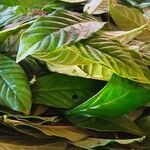erately carinate, longitudinally venose. Inflorescences terminal, spreading, panic-ulate, usually shorter than the uppermost leaves; peduncles 2-3 cm long, angular, glabrate, the rachis zigzag, the branches few, usually opposite, the flowers dis-posed in well separated, few-flowered glomerules giving a spikelike appearance, the bracts caducous. Flowers sessile, minute; hypanthium short, rounded basally, puberulent, the calycine cup scarcely measurable, truncate, the teeth absent; corolla greenish white or white, the lobes 5, deltoid, apparently longer than the tube, to 1 mm long, densely white villose within; anthers subsessile, oblong, 0.35 mm long; ovarian disc compressed rotund, 0.6 mm long, the style ca. 0.4 mm long, conspicuously swollen above the middle, the stigmas ca. 0.15 mm long. Fruits sessile, oblong, 4-5 mm long, truncate at the apex, rounded at the base, drying dark, distinctly costate, glabrate, the calycine cup, if persistent, very short.
More
Small trees or shrubs, the twiglets slender, smooth, glabrous or puberulent, terete but ultimately angular, the nodes well spaced. Leaves elliptic, elliptic ob-long or obovate oblong, often falcate, occasionally inequilateral, 6-14 cm long, 2.0-4.5 cm wide, acute to rounded or obtuse at the apex, acuminate, the acumen usually widely triangular, to 0.8 cm long, ultimately obtuse, usually attenuate acute at the base, the costa plane above, subprominent beneath, the lateral veins 7-10, arcuate, joining to form a vague, undulate submarginal vein to 2 mm from the margin, stiffly papyraceous, concolorous, usually drying brown, glabrate to minutely golden pubescent above and beneath; petioles 0.3-1.0 cm long; stipules free, oblong or ovate oblong, to 2 cm long, usually deltoid or conspicuously narrow toward the apex, stiffly scarious, ciliate, otherwise glabrate, usually mod-
Moist or wet thickets, or an understorey plant in dense or moderately dense rainforest, often on limestone soils, at elevations up to 150 metres.

